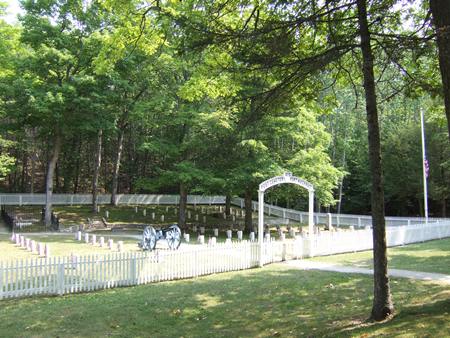Fort Mackinac Post Cemetery

Office Hours: Monday thru Friday 8:00 a.m. to 4:30 p.m.
Closed federal holidays.
Visitation Hours: Open daily from sunrise to sunset.
This cemetery is closed to interments.
Burial in a national cemetery is open to all members of the armed forces who have met a minimum active duty service requirement and were discharged under conditions other than dishonorable.
A Veteran's spouse, widow or widower, minor dependent children, and under certain conditions, unmarried adult children with disabilities may also be eligible for burial. Eligible spouses and children may be buried even if they predecease the Veteran.
Members of the reserve components of the armed forces who die while on active duty or who die while on training duty, or were eligible for retired pay, may also be eligible for burial.
Directions from Detroit Metropolitan Airport: From the Airport, merge onto I-94 W toward Chicago; Merge onto I-275 N via Exit 194 toward Flint; Merge onto I-96 W via the exit on the left toward Lansing; Merge onto US 23 N via Exit 148B toward Flint; take I-75 to Mackinaw City, MI; take the James St exit into downtown. In Mackinaw City take the ferry landing exit. Take the ferry (fee charged) to Mackinac Island. Cemetery is located behind the fort.
Directions from Bishop International Airport (Flint, MI): Go East on W Bristol Rd toward Torrey Rd; take the I-75 N / US 23 N ramp toward Saginaw. Stay on I-75 / US 23 N to mackinaw City, MI. In Mackinaw City take the ferry landing exit. Take the ferry (fee charged) to Mackinac Island. Cemetery is located behind the fort.
Fax all discharge documentation to the National Cemetery Scheduling Office at 1-866-900-6417 and follow-up with a phone call to 1-800-535-1117.
For information on scheduled burials in our national cemeteries, please go to the Daily Burial Schedule.
There is no office at this cemetery. It is overseen by Great Lakes National Cemetery.
Please contact the national cemetery for more information.
For educational materials and additional information on this cemetery, please visit the Education section, located below.
Floral arrangements are not authorized at any time in the cemetery.
VA regulations 38 CFR 1.218 prohibit the carrying of firearms (either openly or concealed), explosives or other dangerous or deadly weapons while on VA property, except for official purposes, such as military funeral honors.
Possession of firearms on any property under the charge and control of VA is prohibited. Offenders may be subject to a fine, removal from the premises, or arrest.
Located in the Straights of Mackinac, which connect Lake Michigan and Lake Huron, Mackinac Island played a significant role in early American history due to its strategic location. Control of the island changed hands numerous times leading up to and after the establishment of the American republic. The French first occupied Mackinac Island in the 17th century, surrendering it to the British after the French and Indian War. The British fortified the island toward the end of the Revolutionary War, yielding it to the United States in 1796. British forces recaptured the fort at the outbreak of the War of 1812, only to relinquish control to the Americans again at the cessation of the war.
Fort Mackinac Post Cemetery is located approximately a half mile north of Fort Mackinac, near Skull Cave, a burial site for American Indians. The earliest interments in the post cemetery likely date to the mid-1820's. The military occupation of Fort Mackinac throughout the 18th century suggests there was an earlier post cemetery, yet the location of pre-1820’s burials remains elusive. The earliest interments are located on the north and west sides of the post cemetery, which was enlarged between 1873 and 1890.
In 1875, in response to the increasing popularity of Mackinac Island as a tourist destination, the federal government established Mackinac Island National Park. It was the second national park established in the United States, after Yellowstone National Park. With the close of Fort Mackinac in 1895, military operations on the island came to a halt, and the federal government ceded the park to the state of Michigan.
Throughout most of the 20th century, the state maintained the grounds, save for a period in the late 1930's, when the Civilian Conservation Corps, a New Deal work-relief program, landscaped and improved the cemetery. In 1990, the Department of Veterans Affairs assumed responsibility for the maintenance of the cemetery through an agreement with the state.
Today, the rectangular post cemetery is bounded by a white picket fence with a wooden archway marking the entrance. Of the approximately 108 burials in Fort Mackinac Post Cemetery, 69 are unknown. In addition to the soldiers and their families, six civilians are interred at the post cemetery.
Mackinac Island, Michigan, including Fort Mackinac Post Cemetery, was designated as a National Historic Landmark in 1960.
Under Development.
We are developing educational content for this national cemetery, and will post new materials as they become available. Visit the Veterans Legacy Program and NCA History Program for additional information. Thank you for your interest.

















